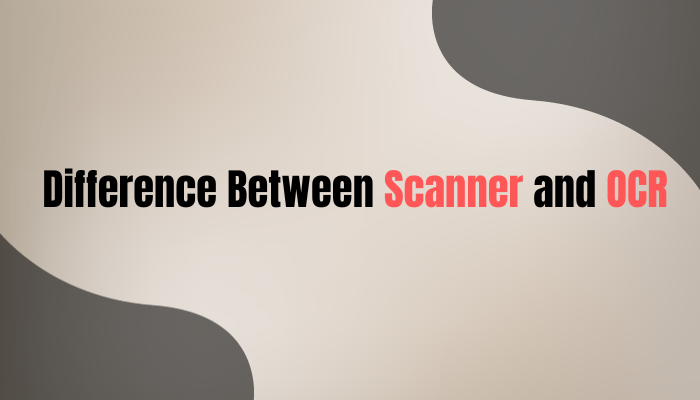Technology | 5 Minutes Reading
Difference Between Scanner and OCR – Complete Comparision

When it comes to digital documentation, two crucial tools come into the picture; scanners and OCR. These two tools are often misunderstood as similar tools. However, they serve distinct purposes. Hence, in this write-up, we will explore the difference between scanner and OCR to understand their usage and significance in the field of email forensic investigation.
OCR vs Scanner
A scanner is a device that can convert physical documents, images, or objects into a digital format. The scanning process includes capturing visual information on a physical document and creating a digital replica.
One can store, edit, or share these digital documents via electronic medium. Flatbed scanners, sheet-fed scanners, handheld scanners, etc some of the types of scanners.
Unlike scanners, OCR or Optical Character Reader is a software technology that can recognize and interpret text from scanned documents or images. It can further convert it into editable and searchable data. With the help of this, one can employ sophisticated algorithms to identify characters, words, and layout structures within an image.
Understanding the Forensic Significance of OCR vs Scanner
Scanners
In the case of forensic analysis, scanners play a crucial role in digitizing physical evidence. It comes in a great deal for scanning documents, images, etc, and preserving them in the original state of evidence.
Secondly, scanners are used to document evidence in digital form accurately. The digital form of documents allows investigators to zoom in on specific areas for closer analysis. Thus, scanners play a crucial role in forensics investigations where minute details hold significant value.
Last but not least, when it comes to sharing and collaborating, digital or scanned documents come in handy. It helps forensic experts, law enforcement agencies, and legal professionals expedite the investigation process.
OCR
It is a powerful tool that helps in extracting text from scanned documents. It enables forensic professionals to search for keywords, phrases, or patterns within the content. This extraction capability is essential in unearthing hidden information or encrypted messages.
Secondly, it can be helpful in examining the metadata of a digital document. That includes analyzing document creation dates, author information, document revisions, etc. In this way, it can provide an additional layer of context to the evidence.
Last but not least, sometimes, OCR can aid forensic linguists in language analysis. This helps experts identify the text content. Linguistic patterns, and writing styles. Also, it gives insights into the origin, authorship, or potential connections between multiple documents.
Difference Between Scanner and OCR – Bridging the Gap
Even though OCR and scanners have different purposes, their combined powers are frequently used in thorough forensic investigations. Physical evidence is scanned to obtain visual information, and then the scanned images are subjected to OCR to extract meaningful text data. By working together, investigators can fully utilize both technologies, which improves the forensic workflow.
Recording Chain of Custody: By generating a digital trail of evidence, scanners record the chain of custody. By retrieving pertinent data from documents, OCR enhances this procedure and helps demonstrate the legitimacy and provenance of the evidence.
Digital Reconstruction of Documents: It is possible with scanned images and OCR. By combining several technologies, forensic professionals can better piece together documents that have been destroyed or destroyed and retrieve important data that could be essential to an inquiry.
Note: If you are in search of a professional tool with OCR capabilities for investigating emails in bulk then MailXaminer is the best choice.

Conclusion
In this write-up, we’ve discussed the difference between scanner and OCR for your understanding. The way evidence is gathered, examined, and presented has been completely transformed by the use of scanners and OCR technologies. Evidence’s physical integrity is maintained by scanners, but OCR allows for the extraction of insightful data from digital copies. This cooperative method improves the precision and comprehensiveness of forensic analyses while also hastening investigations.
FAQs
Q- Is optical character recognition (OCR) a software program or a hardware tool like a scanner?
OCR: Basically, optical character recognition (OCR) is a software program or technology that may be included in many devices, such as scanners, to allow them to recognize and process text.
Q- Is it possible for a scanner to do OCR without the need for further software?
In general, not. While some sophisticated scanners can recognize text on a basic level, OCR software is often needed for full OCR performance.
Q- Is it possible to use OCR without a hardware scanner?
Indeed, OCR can function without a hardware scanner. OCR software can be used to process PDFs, digital photos, and other text-containing files.
Q- Are OCR features available on all scanners?
No, not every scanner has OCR built into it. While OCR functionality is typically present in more sophisticated or specialized scanners or through the use of external OCR software, basic scanners may merely be able to capture and save images.
Q- Is OCR limited to text recognition, or is it also capable of identifying other aspects inside a document?
Although text recognition is the main application for OCR, more sophisticated OCR systems might also be able to recognize and extract other document features including tables, forms, and certain data fields.


